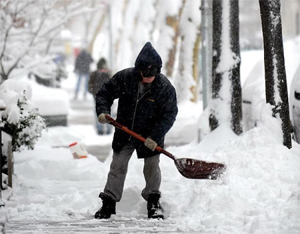Photo and Article: West Virginia Extension
 Stay safe from slips and strains by following these recommendations for safe and effective snow removal.
Stay safe from slips and strains by following these recommendations for safe and effective snow removal.
- Shovel all sidewalks adjacent to your property to the bare pavement. This includes any sidewalks outside your fence lines and to the sides/rear of your property.
- Clear a path at least 36 inches wide. This allows space wide enough for someone using wheelchair, walker or stroller.
- Strategically pile snow. Don’t create new problems in the street or sidewalk when clearing your car or driveway.
- Clear ramps at corners and crosswalks. These strategic spots are particularly dangerous and often overlooked.
- Chop or melt all ice. Ice is the primary cause of falls; it’s not enough to simply remove the snow.
- Keep street storm drains clear of snow and report clogged drains. The snow will melt, and effective drainage protects streets from icing over and developing potholes.
- Clear snow around any fire hydrants near your house. Seconds count when a fire occurs and it’s critical for firefighters to find and access hydrants.
- Shovel frequently. Don’t wait until the snow piles up. Shovel intermittently – after two (2) inches of snow has fallen – to maintain safe conditions and prevent injury when clearing snow and ice.
Be neighborly. Consider helping those who may have difficulty clearing their own sidewalks.
Important health and safety reminders when clearing snow and ice:
- Stretch during and after working outside. Gently stretch your back, arms and legs to help prevent injury and muscle strain.
- Keep dry. Change wet clothes frequently to prevent a loss of body heat. Wet clothing loses all of its insulating value and transmits heat rapidly.
- Cover your mouth. Protect your lungs from extremely cold air by covering your mouth when outdoors.
- Wear shoes with good soles. Falling is the most common injury when removing snow and ice.
- Wear shoes with a good cleat tread and layers of absorbing socks.
- Separate your hands on the shovel. By creating space between your hands, you can increase your leverage on the shovel.
- Lift with your legs, not your back. Make sure your knees are bending and straightening to lift the shovel instead of leaning forward and straightening with the back.
- Push the snow. It is easier and better for your back to push the snow rather than lift it. Never throw snow over your shoulders.
- Avoid overexertion. Cold weather puts an added strain on the heart. Unfamiliar exercise, such as shoveling snow or pushing a car, can bring on a heart attack or make other medical conditions worse.
- Stay safe. Walk carefully on snowy and icy sidewalks. If using a snowblower, NEVER use your hands to unclog the machine.
- Maintain an awareness of utilities when removing snow. Do not cover fire hydrants with snow when clearing sidewalks and driveways. Do not shovel snow into the street storm drains.
Offer to help individuals who may require special assistance. Seniors and people with disabilities can benefit from a thoughtful neighbor, and they often need extra help during snowy conditions.